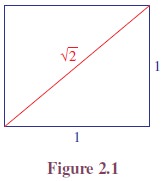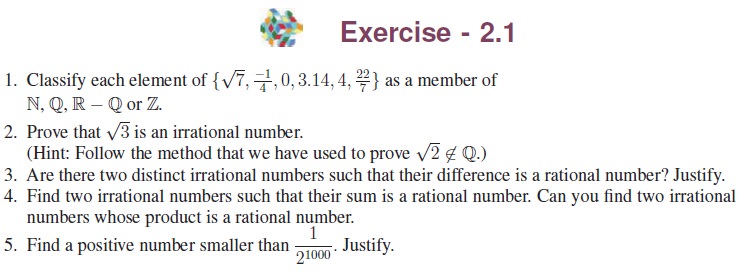Properties, Formula, Solved Example Problems, Exercise | Mathematics - Real Number System | 11th Mathematics : UNIT 2 : Basic Algebra
Chapter: 11th Mathematics : UNIT 2 : Basic Algebra
Real Number System
Real Number System
First we shall recall how the
real number system was developed. We start with natural numbers N.
1. Rational Numbers
Note that N = {1,
2,
3, . . . } is enough for
counting objects. In order to deal with loss or debts, we enlarged N to the set of all integers, Z = {. . . , −4, −3,
−2, −1, 0, 1,
2, . . .} , which consists of the
natural numbers, zero, and the negatives of natural numbers. We call {0, 1, 2,
3,
· · · } as the set of whole numbers and denote it by W.
Note that it differs from N by just one element, namely, zero. Now imagine dividing a cake
into five equal parts, which is equivalent to finding a solution of 5x
= 1. But this equation cannot be solved within Z. Hence we have enlarged Z to the set Q –{ m/n | m, nÎZ, n¹0} of ratios; so we call
each x ∈ Q as a rational number. Some examples of rational numbers are

We have seen in
earlier classes that rational numbers are precisely the set of terminating or
infinite periodic decimals. For example,

2. The Number Line
Let us recall “The Number Line”. It is a horizontal
line with the origin, to represent 0, and another point marked to the right of 0 to represent 1. The distance from 0 to 1 defines one unit of
length. Now put 2 one unit to the right
of 1. Similarly we put any positive rational
number x to the right of 0 and x units away. Also, we
put a negative rational number −r, r > 0, to
the left of 0 by r units. Note that for any x, y ∈ Q if x<y, then x
is to the left of y; also x < (x + y)/2
< y and hence between any two distinct rational numbers there is
another rational number between them.
Question:
Have we filled the whole line
with rational numbers?
The answer to the above question
is “No” as the following consideration demonstrates. Consider a square whose
side has length 1 unit. Then by Pythagoras theorem its diagonal has length √2
units.

3. Irrational Numbers
Theorem 2.1: √2 is not a rational number.
Proof. Suppose that √2 is a rational number. Let √2 = m /n , where m
and n are positive integers with no common factors greater than 1. Then, we
have m2 = 2n2, which implies that m2 is even
and hence m is even.
Let m = 2k. Then, we have 2n2
= 4k2 which gives n2 = 2k2.
Thus, n is also even.
It follows, that m and n are even
numbers having a common factor 2.
Thus, we arrived at a
contradiction.
Hence, √2 is an irrational number.
Remark:
(i) Note that in the above proof
we have assumed the contrary of what we wanted to prove and arrived at a
contradiction. This method of proof is called ‘proof by contradiction’.
(ii) There are points on the
number line that are not represented by rational numbers.
(iii) We call those numbers on
the number line that do not correspond to rational numbers as irrational
numbers. The set of all irrational numbers is denoted by Q’ (For number line
see Figure 1.2.)

Every real number is
either a rational number or an irrational number, but not both. Thus, R = Q ∪ Q’ and Q ∩ Q’ = ∅.
As we already knew
that every terminating or infinite periodic decimal is a rational number, we
see that the decimal representation of an irrational number will neither be
terminating nor infinite periodic. The set R of real numbers can be visualized as the set of points on the
number line such that if x < y, then x lies to left of y.
Figure 2.2
demonstrates how the square roots of 2 and 3 can be identified on
a number line.

We notice that N ⊂ W ⊂ Z ⊂ Q ⊂ R.
As we have already
observed, irrational numbers occur in real life situations. Over 2000 years ago people in the Orient and Egypt
observed that the ratio of the circumference to the diameter is the same for
any circle. This constant was proved to be an irrational number by Johann
Heinrich Lambert in 1767. The value of π rounded off to nine
decimal places is equal to 3.141592654. The values 22/7 and 3.14, used in
calculations, such as area of a circle or volume of a sphere, are only
approximate values
for π.
The number π, which is
the ratio of the circumference of a circle to its diameter, is an irrational
number.
Now let us recall the
properties of the real number system which is the foundation for mathematics.
4. Properties of Real Numbers
(i) For any a, b ∈ R, a + b ∈ R and ab ∈ R.
[Sum of two real
numbers is again a real number and multiplication of two real numbers is again
a real number.]
(ii) For any a, b, c ∈ R, (a + b) + c = a + (b + c) and a(bc)=(ab)c.
[While adding (or
multiplying) finite number of real numbers, we can add (or multiply) by grouping
them in any order.]
(iii) For all a ∈ R, a +0= a and a(1) = a.
(iv) For every a ∈ R, a + (−a)=0 and for every b ∈ R − {0}, b (1/b) = 1.
(v) For any a, b ∈ R, a + b = b + a and ab = ba.
(vi) For a, b, c ∈ R, a(b + c) = ab + ac.
(vii) For a, b ∈ R,a<b if and only if b − a > 0.
(viii) For any a ∈ R, a2 ≥ 0.
(ix) For any a, b ∈ R, only one of the following holds: a = b or a<b or a >
b.
(x) If a, b ∈ R and a < b, then a + c<b + c for all c ∈ R.
(xi) If a, b ∈ R and a < b, then ax < bx for all x > 0.
(xii) If a, b ∈ R and a < b, then ay > by for all y < 0.

Related Topics